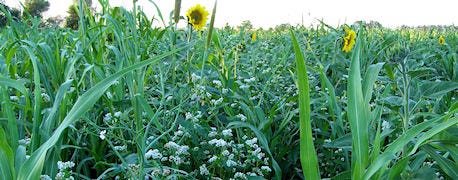February 25, 2013

By Lynn Betts
Let's go straight to the bottom line: "No one species can deliver all the advantages multiple cover crops deliver in combination," says David Lamm of the USDA Natural Resources Conservation Service.
That's why most farmers who start with single species cover crops eventually move to mixes. "Some fix nitrogen. Some are very good at scavenging leftover nitrogen in the soil. Some have deep roots that extend benefits deeper into the soil profile. Still others help control specific weeds or attract beneficial insects," adds this leader for the NRCS National Soil Health and Sustainability Team at Greensboro, N.C.

DIVIDENDS FROM DIVERSITY: A single cover crop is a good start, but multiple species deliver many more benefits.
The value of cover crops isn't in the biomass produced above ground. Rather, it's in the diversity of plant roots that create underground habitat with a healthy balance of predator and prey organisms. That balance improves nutrient cycling and puts organic matter production on the fast track, he declares.
Cocktail mixes pay, even in drought
Jay Fuhrer, a district conservationist with NRCS in Burleigh County, N,D., discovered exactly that while working with several dozen farmers using cover crop mixes. One of his clients bumped their organic matter levels from as low as 1.7 to as high as 5.0.

"Using one or two species is a step in the right direction," says Fuhrer. "But you get more benefits from using several cover crops together. The benefits are exponential with the synergy you create to feed the soil biology with a dozen species together. You can actually accelerate biological time in nutrient cycling."
Fuhrer says first-time cover crop users tend to use only one or two species because they think that's simplest. "A multiple-species planting is actually easier and safer to manage than a single species cover crop," he argues. "The more diversity you have, the more soil biology balance you have below ground."
~~~PAGE_BREAK_HERE~~~That point comes through very clearly in a drought, according to Fuhrer. While monocultures struggle," he says, "we've watched 6 to 8 species cocktail mixes flourish in dry times. And, those mixtures work together to crowd out weeds."
Shoot for four plant groups
Using mixtures that include both warm and cool season plants, and both grasses and broadleaf plants, is ideal. Lamm suggests seeding plants representing four functional groups:
•Warm season grasses (corn, millet, sudex);
•Warm season broad leafs (soybeans, buckwheat, sunflowers);
•Cool season grasses (cereal rye, wheat, triticale); and
•Cool season broadleafs (clovers, radish, turnips).
Having two or three representatives from each group would be ideal. But he admits there's a practical side to consider.
Seed availability, cost, seeding methods, ability to terminate the plants and other factors enter into how many species you might use. Some studies suggest six to eight species from three of the groups would be about right.
NRCS plant materials centers, including the one in New York, are conducting a three-year study to look at this. For the northern Corn Belt, Lamm says common mix species are cereal rye, hairy vetch, winter peas and daikon radish. In the South and Southeast, a common mix includes cereal rye, hairy vetch, crimson clover, and daikon radish.
Don't limit yourself to those mixes, he adds. Experiment to see what works best on your soils. Consider the plant traits noted in the accompanying table.
Betts writes from Johnston, Iowa.
You May Also Like




